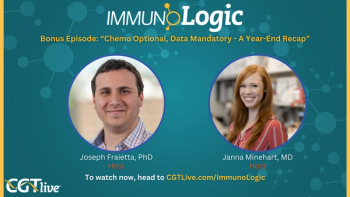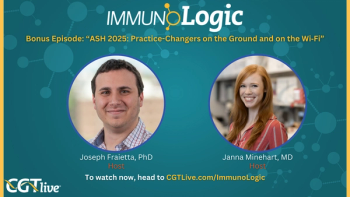
Improving CAR Lymphoma Treatments With Epstein-Barr Virus T-Cell Therapy
Findings from an ongoing phase 1 trial were presented at the 2021 ASGCT meeting.
This content originally appeared on our sister site,
Encouraging data from an ongoing phase 1 trial (NCT04288726) evaluating an off-the-shelf, allogeneic CD30-CAR Epstein Barr virus–specific T-cell (EBVST) therapy (TT11X) in patients with lymphoma were presented during the American Society of Gene and Cell Therapy 2021 Virtual Annual Meeting in May.1,2
Results were reported even at low dose levels, according to the study’s authors. A total of 19 patients were recruited; of the 6 patients determined to be evaluable for efficacy, 3 patients achieved disease control with partial responses (PRs) to treatment, whereas 2 experienced disease progression.
“Off-the-shelf CD30-CAR EBVSTs have been shown to be safe and clinically active,” David Hon Quach, PhD, lead study author and postdoctoral associate at the Center for Gene Therapy at Baylor College of Medicine in Houston, Texas, said during a presentation on the data. “We want to monitor these patients to determine the durability of their clinical response, and we want to investigate the localization of our CD30-CAR EBVSTs because it is important to be able to determine whether they are present so we can evaluate whether our cells are protected from rejection.”
There are challenges associated with off-the-shelf T-cell therapy. Those derived from a donor alloreactive T-cells can cause graft-versus-host disease (GVHD), and rejection is mediated by recipient alloreactive T-cells.
GVHD is caused by donor alloreactive T cells, and rejection is caused by recipient alloreactive T cells. For an off-the-shelf therapy to be successful, it must be able to overcome these issues. To this end, investigators set out to examine EBVSTs expressing CD30-CAR as a potential off-the-shelf option.
Several cell platforms have been investigated to address the issue of GVHD. Most autologous T-cell therapies have used αβ T cells that can knock out a T-cell receptor (TCR) to eliminate alloreactivity. Other T cells have restricted or invariant TCRs, such as γδ T cells, virus-specific T cells (VSTs), or natural killer T cells. Quach and colleagues focused on using VSTs as a cell platform.
“There are so many benefits to VSTs in cell therapy. First, they are very safe in the allogeneic transplant setting. Hundreds of patients have been treated with the cells derived from the donor or a third party, and in all of these trials rarely has any GVHD been seen,” Quach explained. “Also, EVSTs have been shown to proliferate in patients, and they possess memory and have the potential to persist long term. EVSTs can also expand in response to viral reactivation, and they can localize to lymphoid tissues and sites of inflammation.”
Due to this, EBVSTs were explored as an off-the-shelf therapy in patients with EBV-positive lymphoma. Among the 19 patients treated, 4 achieved complete responses, and 5 had stable disease. However, 10 patients experienced progression.
“We believe that this might be due to a lack of persistence of our cells because these cells are allogeneic, and therefore can potentially be rejected by the recipient’s alloreactive T cells,” Quach noted.
As such, Quach and colleagues proposed a new strategy to prevent rejection. To do this, investigators set out to target recipient alloreactive T cells. They hypothesized that if a marker was expressed on the alloreactive T cells, they could design a chimeric antigen receptor (CAR) to target that marker, which would allow for the CAR T cells to eliminate those alloreactive T cells, thus protecting the CAR cells from rejection.
“CD30 is a molecule that is upregulated on alloreactive T cells when stimulated by allogeneic targets, and so, luckily, there has been a CAR that was designed against CD30,” Quach said. “The CD30-CAR has actually been tested clinically and shown to be both safe in patients and effective against CD30-positive lymphomas. As such, we are developing a CD30expressing EBVST as an off-the-shelf therapy.”
Because EBVSTs are not known to cause GVHD, the cells were hypothesized to be safe. Additionally, the cells possess the capability to eliminate alloreactive T cells and should not be rejected. Moreover, as effectors, they should be able to eliminate CD30-positive tumors that are either EBV positive or negative; they should also be able to kill EBV-positive tumors that are either CD30 positive or negative, according to Quach.
Previously, Quach and colleagues evaluated these cells in an in vitro model to determine whether the cells could be protected from rejection. Investigators cultured EBVTs with allogeneic peripheral blood mononuclear cells that contained alloreactive T cells. Within the culture, investigators anticipated that the alloreactive T cells would eliminate the EBVSTs and predominate in the culture, unless the EBVSTs expressed CD30-CAR.
In the CD30-CAR condition, they observed persistence of the EBVSTs and a limited expansion of the alloreactive T cells. Based on these data, they went on to evaluate whether this off-the-shelf treatment could be effective in patients. As such, they launched the phase 1 trial where they evaluated the therapy in patients with relapsed/refractory, CD30-positive Hodgkin lymphoma or non-Hodgkin lymphoma.
The objectives of the research were to examine the safety of the approach, determine the persistence of the CD30-CAR EBVSTs, and evaluate the antitumor activity with the therapy.
Study participants previously received lymphodepletion chemotherapy of cyclophosphamide at a daily dose of 500 mg/m2 plus fludarabine at a daily dose of 30 mg/m2. Three different dose levels were evaluated. Patients start at dose level 1, which was 4 × 107 cells, and can be escalated to dose level 2 (1 × 108 cells) and dose level 3 (4 × 108 cells). After infusion, investigators draw blood on a weekly basis to measure the transgene and evaluate epitope spreading. In weeks 6 to 8, investigators perform diagnostic scans to examine the efficacy of the treatment.
The investigators generated a bank of 7 lines of CD30-CAR EBVST that were derived from healthy donors. They characterized the lines to determine whether they were able to kill through the CAR and maintain EBV specificity.
“In determining the donor line to use to treat patients, we have actually decided to select the line that has the best human leukocyte antigen match between patient and donor because this will allow our EBVSTs to expand in response to EBV reactivation if present in patients,” Quach explained.
One of the patients, a 34-year-old woman with relapsed Hodgkin lymphoma, received the therapy at dose level 1. On her preinfusion scan, the patient had disease in the lymph nodes in the abdomen and the pelvis; she had bone lesions, as well. By week 6 of treatment, most areas of her disease had resolved, however, 1 site had residual disease. As such, the patient was determined to have a PR to the therapy.
Another patient, a 39-year-old woman with relapsed Hodgkin lymphoma, received the therapy at dose level 2. At 6 weeks, most of the disease in her lymph nodes in the chest and neck had been resolved with treatment. However, the patient had 1 solitary site of residual disease, so she was graded as having a PR.
Additionally, a 29-year-old man with relapsed Hodgkin lymphoma (patient #3) had a low tumor burden before cell therapy infusion. By week 6, the patient went on to develop a new lesion. The lesion was biopsied and determined to be CD30 positive, so the patient was graded to have disease progression.
All patients had weekly blood draws following infusion with the therapy, which allowed investigators to examine the presence of CD30CAR EBVSTs in their blood by measuring the transgene with quantitative polymerase chain reaction. In the 3 patients who received dose level 1 and the 2 patients who received dose level 2, investigators detected cells present at the time of infusion, but rapid loss thereafter, except for patient #3 who had expansion following infusion.
“This result is quite puzzling to us, given the fact that even though there [do] not seem to be any cells present in the blood, there are many patients who did have a clinical response,” Quach said. “The reason why we believe that is possible is that our CD30-CAR EBVSTs may be simply trafficking completely to the sites of disease, which, in our case, would be the lymph nodes or the bone marrow. Therefore, they would not present in the blood.”
When looking at the copy number analysis, investigators reported that most patients had peak transient expression at the time of infusion, whereas patient #3 had a peak at week 1. Moreover, 4 different donor lines were used to treat patients, and the first 3 patients were treated with the same line.
In the next steps for this research, Quach and colleagues want to infuse additional doses of the CD30-CAR EBVSTs to induce a greater response or achieve a more durable response. They would also like to treat patients with CD30-negative, EBV-positive lymphoma, Quach concluded.
References:
1. Quach DH, Ramos CA, Lulla PD, et al. Activity of banked (off -the-shelf) CD30.CAR-modified Epstein-Barr virus-specific T cells in patients with CD30-positive lymphoma. Presented at: American Society of Gene and Cell Therapy 2021 Virtual Annual Meeting; May 11-14, 2021; virtual. Abstract 195.
2. Tessa Therapeutics announces positive topline data from ongoing phase 1 trial of allogeneic, “off -the-shelf” cell therapy, in patients with relapsed or refractory CD30-positive lymphoma. News release. Tessa Therapeutics Ltd. May 14, 2021. Accessed May 14, 2021. https://bit.ly/3vYvVV0
Newsletter
Stay at the forefront of cutting-edge science with CGT—your direct line to expert insights, breakthrough data, and real-time coverage of the latest advancements in cell and gene therapy.





































